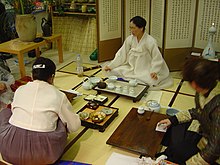Korean tea ceremony
| Korean tea ceremony | |
 |
|
| Korean name | |
|---|---|
| Hangul | 다례 |
| Hanja | |
| Revised Romanization | darye |
| McCune–Reischauer | tarye |
The Korean tea ceremony or darye(茶禮) is a traditional form of tea ceremony practiced in Korea. Darye literally refers to "etiquette for tea" or "day tea rite" and has been kept among Korean people for an over a thousand years. The chief element of the Korean tea ceremony is the ease and naturalness of enjoying tea within an easy formal setting.
Tea ceremonies are now being revived in Korea as a way to find relaxation and harmony in the fast-paced new Korean culture, and continuing in the long tradition of intangible Korean art.
The first historical record documenting the offering of tea to an ancestral god describes a rite in the year 661 in which a tea offering was made to the spirit of King Suro, the founder of the Geumgwan Gaya Kingdom (42-562). Records from the Goryeo Dynasty (918-1392) show that tea offerings were made in Buddhist temples to the spirits of revered monks.
Important national rituals involving tea drinking were being presided over by the government officials of the "Tabang" department. There is at least one ritual recorded in the Goryeosa Yaeji, or The Official History of Goryeo, mentioned as part of receiving a Chinese messenger to the court.
During the Joseon Dynasty (1392-1910), the ritualistic drinking of tea continued and was further refined. "Tabang" sustained and organized main royal ceremony. The royal Yi family and the aristocracy used tea for simple rites, the "Day Tea Rite" was a common daytime ceremony, whereas the "Special Tea Rite" was reserved for specific occasions. They were codified in the 1474 "National Five Rites" (Gukjo Oryeui, 國朝五禮儀, 국조오례의). These terms are not found in other countries.
But plantation problems changed many ways Korean tea was governed. Unlike tea plantation areas in China or Japan, the climate of the Korean Peninsula is much colder and Tea harvesting season occurs just before the spring. So at that period, the tea tree forested areas in the mountains were still so cold and also dangerous because of wildlife. The old Korean name of tea, 설록("Sulloc", 雪綠), means the first flush tea leaf was harvested on the snow field of a mountain. This situation brought lots of trouble during the Goryeo Dynasty and Joseon Dynasty.
The tea tree forested area is also the traditional Breadbasket of Korea and the tea leaf harvesting season and cereal seeding season overlap each other. Because of its value, farmers who lived around tea tree forested regions paid a steep tea tax to the King. So harvesting and treating tea leaf is pointed out as the major cause of the decrease in annual tea crop harvest. In the Goryeo Dynasty, there were hundreds of appeals by many lieges and scholars as or . And finally at the end of the Goryeo Dynasty, recorded in the "YuDuRyuRok(유두유록, 遊頭流錄)", farmers burnt or chopped their tea trees to protest their tea tax. In the case of Joseon Dynasty, governed based by Confucianism, Tabang was sustained for tea ceremony but reduced the scale of tea production in order to protect the agricultural balance. Because of this reason, the development of the tea industry was prevented for a very long time. And except Yangban and the Royal family, Korean original tea drinking culture and ceremony remained in a limited area around tea tree forested regions.
...
Wikipedia
